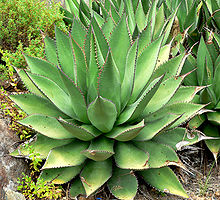User:Vtrigueros/sandbox
Baja California and Gulf of California/Sea of Cortez[edit]
Introduction[edit]
Baja California is not a major part of my life. I have been there a couple times for vacation or to visit family but it is not very common to visit. I am interested to know more about the Baja California and the Gulf of California. Visiting for a couple days is not enough to get to explore the area. I am mostly interested about the wildlife in Baja California. I want to know how different it is from Arizona even if it is the Sonoran Desert. My favorite thing in Baja California would be almost everything that I have experience although it was not a lot. I am really interested to look at everything that has to be researched on Baja California and the Sea of Cortez.
Animal and Plant[edit]
Ctenosaura hemilopha[edit]
This animal is also known as the cape spinytail iguana. They are reptiles that eat mostly plants but they are also able to eat small animals and bugs if they are present. They live in trees, build dens, and sometimes even in cacti. Some people believe that they are in the locations they are today because the Seri Indian people brought them as a source of food. These animals are considered vulnerable because humans are taking over their natural habitat, sometimes they can be hunter to be sold as pets and dogs and cats can pose a threat to them as well. What I think is most surprising about these animals is that they coexist with another type of iguana which is not always common since there may be a limited amount of resources.

Agave shawii[edit]
This plant is also known as Shaw's agave or coastal agave. These plants which are part of the genus agave are drought resistant which makes them great for living in the desert. Their roots respond fast to rain which is a good adaptation for life in the desert. These plants were used by Kumeyaay Native Americans as a source of food, tools, and even clothing. They would make many things by beating the leaves which would result in fibers that they would use for rope, clothing, traps, sandals and many other things.

Land Use[edit]
Baja California is part of Mexico, but is separated by the Sea of Cortez. It is 71,450 km2 with a population of 3,315,766. Land is used in many ways one of them being for real estate. This would make sense with the population they have and the services they would need. Although it has been changing withing the last 1-2 decades because of changes in the border between Mexico and the U.S. The second way that land is used is agriculture. Agriculture is extensively practiced throughout Baja California. Although vegetables and fruits would be a big part of it, there is also wines that are produced by this agriculture. Mining is probably the last main use of land in Baja California. Silver and other precious metals could be mined in this area. One of the wilderness areas in Baja California is Cabo Pulmo National Park. It is a coral reef that has been estimated to be around 20,000 years old with about 800 species living there today. Another wilderness area is El Vizcaíno Biosphere Reserve, which is the largest area of protected land in Mexico.
Threats and Opportunities[edit]
Like many other threats in the world, humans have a big part in this. One big issue in the Baja Californina/Gulf of California area is the vaquita. This small porpoise is threatened by gill-nets that are used to fish another endangered species the totoaba. Gill-nets are nets that are nets that are placed in the water and catch anything that tries to swim through. This is the only place that the vaquita lives in and having these nets makes them face some challenges. Although, regulations on the use of gill-nets have been established, there is still people that illegally use these gill-nets to fish and vaquitas are accidentally being caught an most of them die. They are the most endangered marine mammal of the world with less than 30 in the entire planet and none in captivity. Luckily for the vaquita there is a lot of people that are trying to help. Other than banning gill-net fishing, the Mexican government also tried to help fishers use alternatives to gill-nets so that they still have a way to make a living. Other conservation groups are also trying to remove the gill-nets but there is a lot and they keep getting replaced. Some ways that can help the vaquita is enforcing the ban of gill-nets, educating people about the vaquita and people can ask how the fish you are about to buy was fished.
Resources[edit]
- ^ Agave shawii. (2018, December 18). Retrieved from https://en.wikipedia.org/wiki/Agave_shawii
- ^ Ctenosaura hemilopha. (2018, December 30). Retrieved from https://en.wikipedia.org/wiki/Ctenosaura_hemilopha
- ^ Agave shawii Var. shawii. (n.d.). Retrieved from https://ucjeps.berkeley.edu/eflora/eflora_display.php?tid=82138
- ^ https://www.mmc.gov/priority-topics/species-of-concern/vaquita/
- ^ https://en.wikipedia.org/wiki/Vaquita#Threats
- ^ https://en.wikipedia.org/wiki/Baja_California



